CONVENT-BRED
Preserving heritage in Catholic schools
I grew up in the 1960s when Catholic families sent their children to convent schools. This has been a practice for Filipino families of some means ever since the late 19th century.
The first ones like the Ateneo Municipal and the University of Santo Tomas were located in Intramuros and were mostly for boys. Girls’ convent schools soon followed in the American period around central Manila, where most middle- and upper-class families lived.
Many of these schools moved out or expanded to the suburbs after the war, as they followed the flight to the suburbs.
I hope that most of the heritage buildings in these schools and the campuses themselves are conserved so that these schools continue to prepare our youth for productive and fruitful lives.
We feature here eight landmark girls’ schools in Manila, Mandaluyong and Quezon City. I did these illustrations over the last year under quarantine.
St. Theresa’s College
The original St. Theresa’s College was housed in San Marcelino, Manila. It was set up by the Belgian Missionary Sisters of the Immaculate Heart of Mary (ICM) in 1915. St. Theresa’s College Manila (STCM) became one of the preferred convent schools for girls in Manila. The Second World War saw much of its campus in San Marcelino left in ruins.
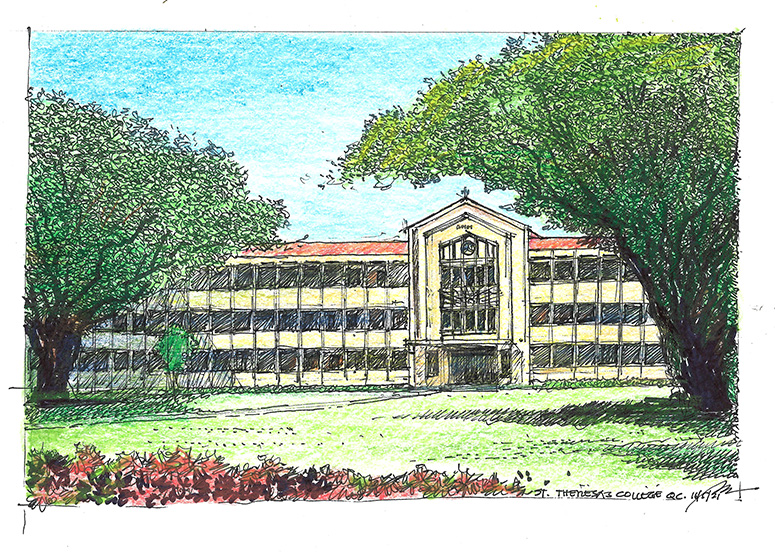
After the war, the Tuason family donated a large plot of land in Quezon City to the school, which then established the Quezon City campus. STCM was still retained, rebuilt and operated until 1980 before shifting all its operations to Quezon City and selling the old campus to Adamson University. My sketch shows the STC Quezon City campus, a sprawling green oasis in that district.
Notable alumnae of STC are Korina Sanchez, Gemma Cruz Araneta, Margie Moran Floirendo, Gilda Cordero Fernando, Jessica Zafra, Mel Tiangco, Leah Navarro, Patricia Evangelista, Millet Mananquil, Letty Magsanoc, Thelma San Juan, Connie Guanzon Garcia, Trina Kalaw, Monina Lacson, Margie Juico, Marilou Diaz Abaya, Lisa Macuja and Loida Nicolas Lewis.
St. Pedro Poveda College
When my family moved to Barrio Kapitolyo in Pasig, my landmark at EDSA would be Tropical Hut and the Institution Teresiana school. There were few buildings in the Ortigas business district then. I took notice of the school also because my dad would hit balls in the driving range beside it and we would putt-putt in the mini-golf amenity there.
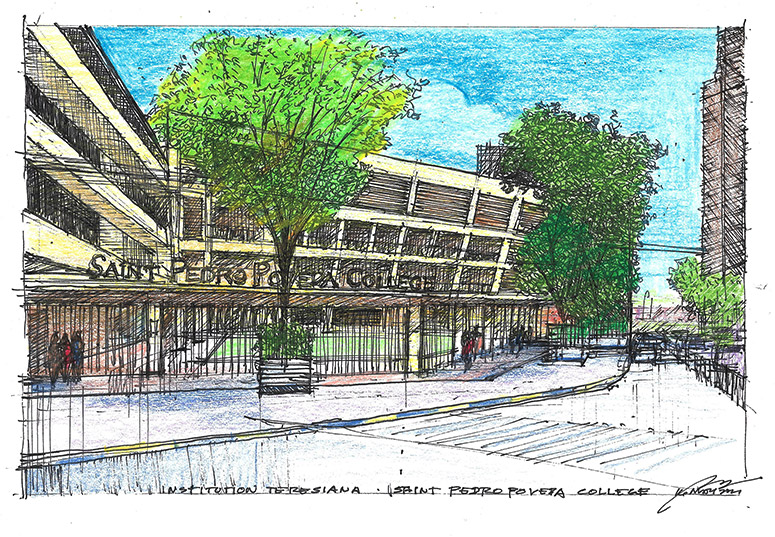
The all-girls’ school was run by Spanish nuns of the Teresian Association of Lay Missionaries. Spanish was taught from kinder to high school. It was a favored institution for girls from the late 1960s onwards as the gated enclaves of the Greenhills villages, the Valle Verdes and Corinthian Gardens filled up.
Famous Povedans include all of the Aquino sisters — Ballsy A. Cruz, Pinky A. Abellada, Viel A. Dee and Kris Aquino, Imee Marcos (who went to Poveda when it was still Institucion Teresiana), Joy Belmonte, Eloisa Francisco Belmonte, Rissa M.Trillo, Raya Mananquil De Leon, Kathy Moran (who later taught at Poveda), KC Concepcion, Mylene Dizon, Mich Dulce, Ria Atayde and my sister-in-law Beng Calma-Alcazaren, the lead singer of Drip.
The school’s name changed in 1974 to Saint Pedro Poveda and eight years ago it became a college. The campus is now the only spot of green in the district aside from the San Miguel complex. I hope it stays that way.
Assumption College
The original pairing of boys’ and girls’ convent schools in pre-war Manila was with the Ateneo and Assumption. The two were neighbors in Ermita behind the University of the Philippines and the PGH of Padre Faura.
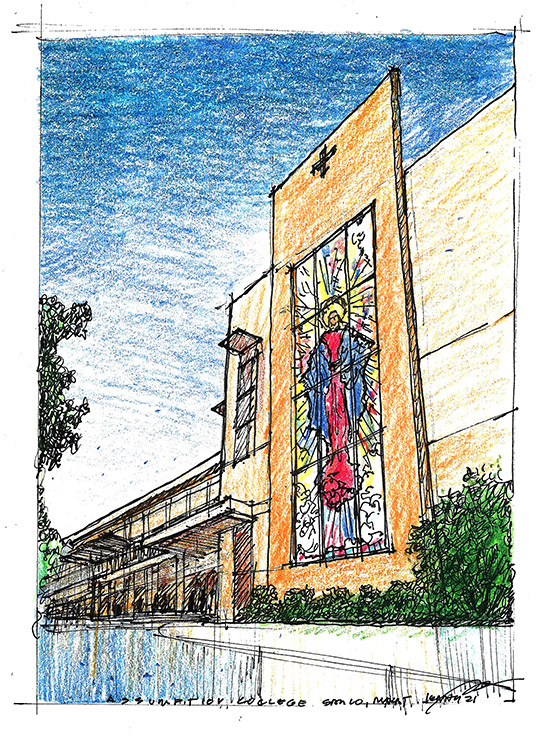
The Assumption school has its origins in a normal school set up in Intramruos in 1892, by the Congregation of the Religious of the Assumption. The revolution stopped its operations but the order came back in the American period and built a new campus in Herran. This, like many other campuses in the district, was heavily damaged in the war. The school rebuilt in 1948 and continued until 1973, when it sold off its property to move completely to the suburbs.
The Makati campus shown in my sketch started operations in 1959, as San Lorenzo Village was set up as one of the exclusive enclaves of the middle class in the new suburban center of Makati. Makati has filled up since then and the school has been one of the educational anchors of the community all these years.
Notable alums include Presidents Corazon Aquino and Gloria Macapagal-Arroyo, Senators Loren Legarda and Grace Poe-Llamanzares, Bambi Harper, Imee Marcos, Judy Roxas, Tessie Sy, Gina de Venecia, Nedy Tantoco, Berna Romulo Puyat, Vicki Belo, Margarita Forés, Leah Navarro, Joey Albert, Tessie Aquino-Oreta, Nadine Lustre, Marissa Concepcion, Monique Toda, Cecile Zamora, Minguita Padilla, Joanne Rae Ramirez, Gang Badoy and Rose Anne Garcia Belmonte.
St. Scholastica’s College
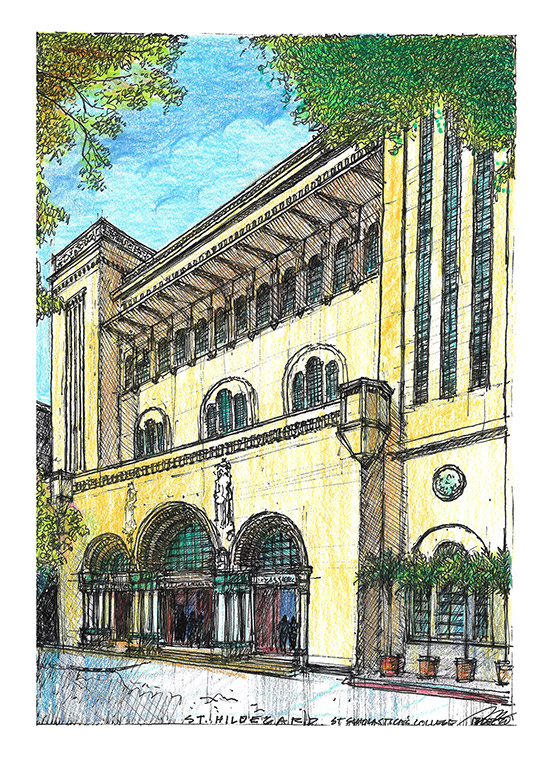
St. Scho, as the school is more popularly known, was set up by five German nuns in December of 1906 and operated in a residence in Tondo. They moved several times until finally settling down in their three-hectare campus in Singalong in 1914, a block away from La Salle.
My late wife, Twink Macaraig, went to school there, graduating from high school in the late 1970s before moving to UP Diliman for her journalism. Maria Ressa was an elementary school classmate and eventual colleague in the field.
Other well-known alums are President Corazon Aquino, Gloria Diaz, Supreme Court Justice Cecilia Muñoz-Palma, Tina Monzon-Palma, beauty queens Gloria Diaz and Aurora Pijuan, Risa Hontiveros, Kitchie Nadal, Nancy Binay, Mitch Valdez, Lucrecia Kasilag and Doreen Fernandez.
St. Paul University Manila
SPU was established in 1912 by the Sisters of St. Paul of Chartres. The nuns originally set up first in Dumaguete in 1904. SPU was all-girls until 2005. The Manila campus grew steadily and was anchored by its distinctive chapel, completed in 1927.
The chapel is in the Art Deco style, one of the first structures in Manila built as such. It was heavily damaged in the war but was quickly rebuilt, along with the campus by the start of the 1950s.
Expansion of the school was more rapid in the 1960s as college courses increased. The school set up campuses in Quezon City (tertiary) and in Pasig (primary and secondary). Both followed the expansion of Manila to the suburbs.
Famous Paulinians are Cristina Ponce Enrile, Cecile Guidote Alvarez, Sharon Cuneta, Pilita Corrales, Charo Santos-Concio, Edu Manzano, Celeste Legaspi, June Keithley, Janet Basco, Maniya Barredo, Tweetie de Leon, Milette Francia Belmonte, Pat-P Daza, Esther Santos, the Revilla sisters, Malu Maglutac and Therese Jamora-Garceau. My sister Isabel and many of my nieces sent their daughters to St. Paul’s.
Maryknoll/Miriam College
Miriam College started in 1926 in Manila. Its first incarnation was as the Malabon Normal School in Malabon. It moved to several locations until it was renamed Maryknoll College, with a modern campus built at Loyola Heights. It was renamed Miriam College in 1989 and turned coed shortly after.
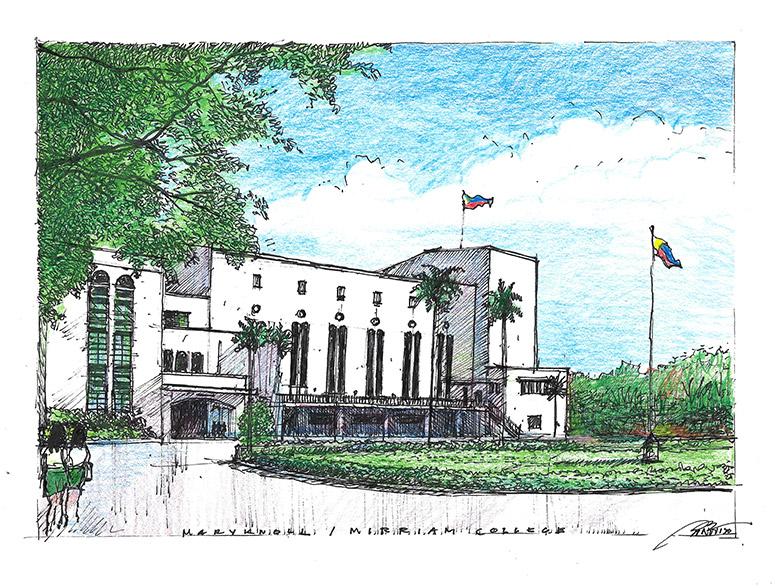
When I was going for my undergraduate studies in the 1970s, the Ateneo and Maryknoll campuses were my landmarks. I drove by these campuses from Pasig, where we had moved in 1967 on a deserted Katipunan Avenue.
I was distracted often by the sight of green-skirted Maryknollers. Many of my classmates at the College of Architecture were Maryknoll alumni, and a number of my schoolmates took their PhDs in Environmental Sciences at the institution, which is one of the greenest in the country in outlook and programs.
Famous Maryknollers are Korina Sanchez, Margie Moran, Patricia Licuanan, Virgie Ramos, Cecilia Ramos Licauco, Josie Cruz Natori, Nieves Confesor and Patis Tesoro.
College Of The Holy Spirit Manila (CHSM)
My mother Rolinda went to high school at the College of the Holy Ghost, as it was called originally. The school was founded in 1913 by the Missionary Sisters Servants of the Holy Spirit.
They first set up a facility on Legarda Street. Ten years later the school expanded and built the first buildings in its present location on Mendiola Street, just next to the Malacañang complex. The school accepted only girls and women until as late as 2005, when they finally went coed, mainly for their noted nursing program.

My mother started there before the war, taking the tranvia from Avenida Rizal where her family lived. World War II just slightly disrupted her studies as she graduated from high school in 1944. She would eventually get accepted at the UP for her medical studies. My mother’s exceptional skills in the arts and literature are a testament of the level of quality of her alma mater. She would regularly attend alumni reunions at the college.
Unfortunately the CHSM is closing in 2022, probably because of the effects of the pandemic. Alumni of the school are concerned about the status of the school’s heritage buildings. Hopefully the sisters get to maintain the campus and its landmark buildings.
Notable alumni from CHSM include Eugenia Apostol, Sylvia Amorsolo-Lazo, Wushu athlete Agatha Wong and comedian Kitkat.
Stella Maris College
The SMC was set up by the Franciscan Missionaries of Mary in 1955. As with the other girls’ convent schools, it only accepted boys fairly recently.
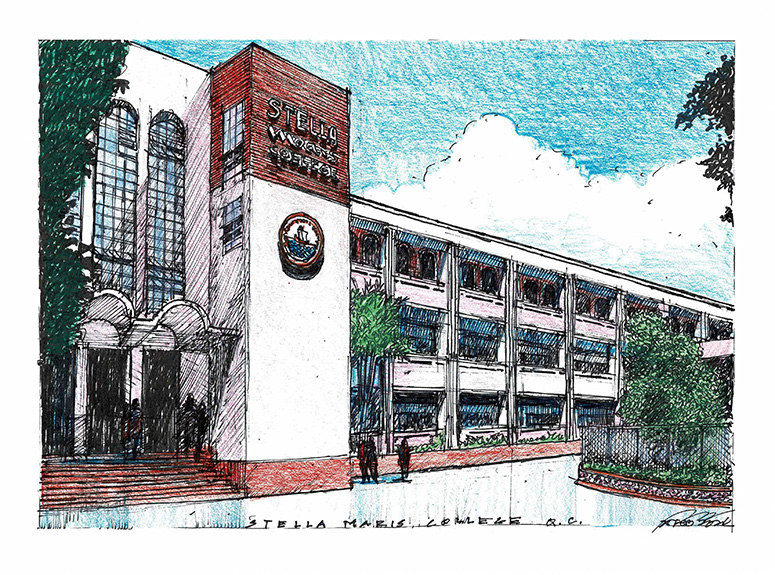
My two sisters went to school at Stella Maris in Cubao. We lived in Project 4 at the time, and I would sometimes accompany my father to fetch them. The campus was a modern landmark on Aurora Boulevard. It was set well back from the boulevard and I remember their wonderfully maintained lawn and agoho trees. You could see the dome of the Araneta Coliseum from the campus.
Unfortunately, the school leased out the front to commercial establishments from the 1970s and its façade could not be seen by the public anymore.
All these schools, their campuses and structures are places of memory for many. They are key landmarks in our large metropolis. I hope that most of the heritage buildings in them and the campuses themselves are conserved so that these schools continue to prepare our youth for productive and fruitful lives.


